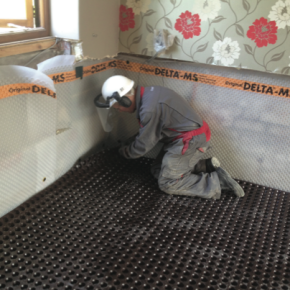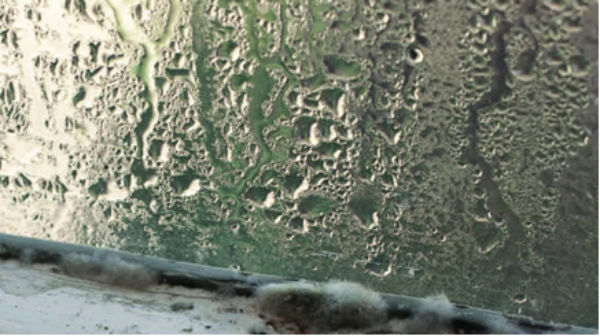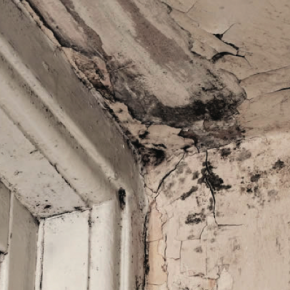
Defeating the damage from damp
Berwyn Evans, UK product manager at Rentokil Property Care, highlights the differing types of damp and the ways in which heating and ventilation impact on moisture in buildings, in the latest issue of ABC+D Magazine.
Making a building watertight is one of the key milestones of the building and construction process as it allows the decorating and interiors tradespeople to commence work.
Yet, for all those efforts to make a building watertight, damp is still a prevalent issue in the UK. By the time a damp problem becomes visible, the damage can be well and truly done – impacting not only the property, but also potentially on the health of the occupants within.
Simply put, damp is unwanted moisture in the structure of a building. It can undermine the structural integrity of a property and inflict serious damage to its interior, causing cracked plaster, peeling wallpaper and rotting skirting boards or structural timbers. There are three common forms of damp: condensation, rising damp and penetrating damp.
Condensation
This is one of the most common forms of damp affecting one in five British homes. It is formed when moist, warm air comes in contact with a cold surface. Everyday activities such as cooking, boiling the kettle, using hot water in the shower or bath, drying clothes inside or even turning the heating down can contribute to condensation forming.
It is most commonly seen between October and April, as windows are typically kept closed and there is a big difference in temperature between the interior and exterior of the building. The occupants of houses that suffer from condensation will typically be producing 14L (24 pints) of water vapour each day.
Ventilation is the key to preventing condensation from forming. With double glazing, keep the trickle vents open. When cooking or boiling a kettle in the kitchen, or using hot water in the bathroom, be sure to keep door closed and use an extractor fan, as warm moist air expands around a property and can then condense on a cold surface.
Heating also plays a vital role in preventing condensation. When using central heating, heat the whole property on a low heat, rather than leaving some rooms cooler and susceptible to condensation.

“There are three common forms of damp: condensation, rising damp and penetrating damp…” Berwyn Evans, Rentokil Property Care.
Rising damp
This occurs if a property does not have a damp course, or if the physical damp course breaks down. Raised flowerbeds or paving against walls can be a common bridge over the damp course. This form of damp can also arise as a result of damage caused by blocked drains, or surface run-off hitting a wall during heavy storms.
If damp patches on walls appear on wet days and disappear on dry days, this can indicate the presence of hygroscopic salts, often as a consequence of rising damp. These salts pull in excess moisture from the air and make the wall surface damp (salt damp) but, when the air dries, so does the wall.
It has been a legal requirement since 1875 for properties to have a damp proof course to prevent water being drawn upwards within the walls, but this does not make them immune. Precautions for rising damp must be made during the construction or renovation phases of a property.
It is vital to ensure that external ground levels are a minimum 150mm below the current damp proof course. If not, this can result in bridging, whereby water enters brickwork or mortar above the damp course – never run hard paving or decking right up to a wall. It is also important to ensure there are sufficient air bricks to provide ventilation to the timber sub-floor, and that they are uncovered and located approximately every 1.8m (six feet).
Penetrating damp
This form of damp can take some time to become apparent. If the property is exposed to the prevailing wind (usually south-westerly), this can drive rain into the masonry, which can then pass through solid walls into the plaster.
The best way to ensure your property is protected from penetrating damp is by applying a weather protect coating to the exterior of a property’s walls. This solution is a breathable, colourless, water-repellent treatment designed to prevent penetrating damp on brick, stone and concrete walls.
One single coat will prevent rain from penetrating a property’s exterior for 20-30 years. This also has positive environmental impacts by improving the wall’s thermal resistance and protecting cavity wall insulation from moisture to improve its performance.
Penetrating damp can also occur when groundwater passes through a basement or earth retaining walls. The solution here is to apply cementitious tanking or a cavity drain membrane system.
Prevention is better than cure
The cost of repairing a damp problem is entirely dependent on the extent of damage to the extent of damage to the property and the type of damp. It can range between a few hundred pounds, to tens of thousands depending on the problem.
Prevention is absolutely better than cure, so be diligent in checking for any signs of damp. If you’re unsure, contact a trained professional. Any delayed action can result in further structural damage to a property.
Latest news

19th April 2024
ASSA ABLOY: Access solutions can impact sustainability performance across the full life-cycle of a building
Embedding sustainability within any organisation requires a broad, strategic perspective. Scrutiny should include the physical infrastructure itself: According to the IEA, buildings consume around 30% of global energy*. ASSA ABLOY has more…
Posted in Access Control & Door Entry Systems, Architectural Ironmongery, Articles, Building Industry News, Building Products & Structures, Building Regulations & Accreditations, Building Services, Case Studies, Doors, Facility Management & Building Services, Information Technology, Research & Materials Testing, Retrofit & Renovation, Security and Fire Protection, Sustainability & Energy Efficiency, Video of the Week
19th April 2024
British weather doesn't dampen spirit for new HMG Garden Paint
Despite one of the wettest starts to the year on record, customers are starting to plan for brighter days with HydroPro Garden Paint from HMG Paints.
Posted in Articles, Building Industry News, Building Products & Structures, Garden, Innovations & New Products, Paints, Paints, Coatings & Finishes, Restoration & Refurbishment, Retrofit & Renovation, Site Preparation, Sustainability & Energy Efficiency, Waste Management & Recycling
18th April 2024
Abloy UK showcases new digital portfolio at The Security Event 2024
Abloy UK is set to unveil its latest line-up of access control systems at The Security Event 2024, welcoming guests to explore its cutting-edge electromechanical and digital solutions on stand 5/F50.
Posted in Access Control & Door Entry Systems, Architectural Ironmongery, Articles, Building Industry Events, Building Industry News, Building Products & Structures, Building Services, Doors, Exhibitions and Conferences, Facility Management & Building Services, Health & Safety, Information Technology, Retrofit & Renovation, Security and Fire Protection
18th April 2024
Strand is a Failsafe Choice for Emergency Exit and Panic Hardware
In times of emergency, you’re in safe hands with Strand Hardware. Although there are many considerations for building specification, few decisions can be as critical as selecting the right emergency exit/panic hardware.
Posted in Access Control & Door Entry Systems, Architectural Ironmongery, Articles, Building Industry News, Building Products & Structures, Building Services, Doors, Facility Management & Building Services, Health & Safety, Restoration & Refurbishment, Retrofit & Renovation, Security and Fire Protection
 Sign up:
Sign up: 